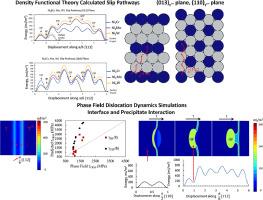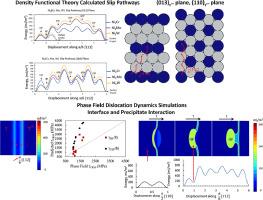含 Ni2(Cr,Mo,W)的海恩斯® 244® 超级合金中剪切模式的相场位错动力学建模
IF 8.3
1区 材料科学
Q1 MATERIALS SCIENCE, MULTIDISCIPLINARY
引用次数: 0
摘要
密度泛函理论(DFT)计算可确定用于强化镍基超合金的有序金属间体系中存在的平面缺陷能量和滑移途径,但用于评估这些相的强化效果的分析模型往往涉及大量简化假设。相反,相场位错动力学(PFDD)是一种有用的建模工具,它结合了位错与沉淀物的相互作用以及 DFT 所提供的滑移途径,从而确定沉淀物在外加应力下可能发生的剪切,其准确性比以前的模型有所提高。在这项工作中,我们应用 PFDD 研究了 HAYNES® 244® 中的沉淀剪切,这是一种通过新型 Ni2(Cr、Mo、W)相强化的高强度镍基超级合金,具有低对称性体心正交(BCO)晶体结构,使滑移路径分析变得复杂。通过建模,我们展示了基体和沉淀物中扩展位错的形成和演变、位错与沉淀物的相互作用以及沉淀物中平面断层的形成。结合 DFT 确定的滑移路径的一个关键方面是不稳定断层能量和能量路径不对称对沉淀强化方面的影响。得出的临界强度与分析模型进行了比较。结果表明,该系统中不同变体的尺寸、取向、颗粒间距和计算出的滑移路径都对这些沉淀物的剪切临界应力有重要影响。本文章由计算机程序翻译,如有差异,请以英文原文为准。


Phase field dislocation dynamics modeling of shearing modes in Ni2(Cr,Mo,W)-containing HAYNES® 244® Superalloy
Density Functional Theory (DFT) calculations can determine planar defect energies and slip pathways that are present in ordered intermetallic systems used to strengthen Ni-based superalloys, but analytical models used to evaluate the strengthening effects of these phases often involve significant simplifying assumptions. Instead, Phase Field Dislocation Dynamics (PFDD) is a useful modeling tool that incorporates dislocation interactions with precipitates and slip pathways informed by DFT to determine how precipitate shearing might occur under applied stresses with improved accuracy over previous models. In this work, we apply PFDD to study precipitate shearing in HAYNES® 244®, a high strength Ni-based superalloy strengthened through a novel Ni2(Cr, Mo, W) phase that has a low symmetry Body Centered Orthorhombic (BCO) crystal structure which complicates analysis of slip pathways. Through our modeling, we show the formation of and evolution of extended dislocations in the matrix and in the precipitates, the interaction of dislocations with the precipitates, and the formation of planar faults in the precipitate. A key aspect of incorporating the DFT determined slip pathway is the influence of the unstable fault energy and the asymmetry of the energy pathway on the strengthening aspect of the precipitate. The resulting critical strengths are compared to analytical models. The size, orientation, particle distance, and calculated slip pathway for the different variants in this system are all shown to have an important effect on the critical stress to shear these precipitates.
求助全文
通过发布文献求助,成功后即可免费获取论文全文。
去求助
来源期刊

Acta Materialia
工程技术-材料科学:综合
CiteScore
16.10
自引率
8.50%
发文量
801
审稿时长
53 days
期刊介绍:
Acta Materialia serves as a platform for publishing full-length, original papers and commissioned overviews that contribute to a profound understanding of the correlation between the processing, structure, and properties of inorganic materials. The journal seeks papers with high impact potential or those that significantly propel the field forward. The scope includes the atomic and molecular arrangements, chemical and electronic structures, and microstructure of materials, focusing on their mechanical or functional behavior across all length scales, including nanostructures.
 求助内容:
求助内容: 应助结果提醒方式:
应助结果提醒方式:


